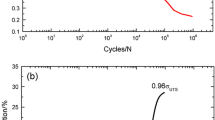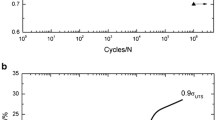Abstract
In fiber-reinforced ceramic-matrix composites (CMC), short-term, rapid oxidation at 1500°C is shown to promote the formation of silicon dioxide. This results in the buildup of a compact film with a high degree of crystallinity; the ensuing effects are closure of pores, self-healing of microcracks, and loss of mass reduced to a minimum. The carbon fibers retain structural integrity in all CMC. This technique can be employed to protect CMC-based components and thus to extend their service life.
Similar content being viewed by others
REFERENCES
I. Yu. Kelina, N. I. Ershova, L. A. Plyasunkova, and A. V. Arakcheev, “Properties of discrete and continuous SiC and C fibers in a hot-pressed silicon nitride matrix,” Ogneup. Tekh. Keram. No. 11, 37 – 44 (2000).
V. A. Lavrenko and Yu. G. Gogotsi, Structural Ceramics Corrosion [in Russian], Metallurgiya, Moscow (1989).
Author information
Authors and Affiliations
Rights and permissions
About this article
Cite this article
Kelina, I.Y., Plyasunkova, L.A. & Chevykalova, L.A. Resistance of Si3N4/Cf Ceramic-Matrix Composites to High-Temperature Oxidation. Refractories and Industrial Ceramics 44, 249–253 (2003). https://doi.org/10.1023/A:1027339717118
Issue Date:
DOI: https://doi.org/10.1023/A:1027339717118




